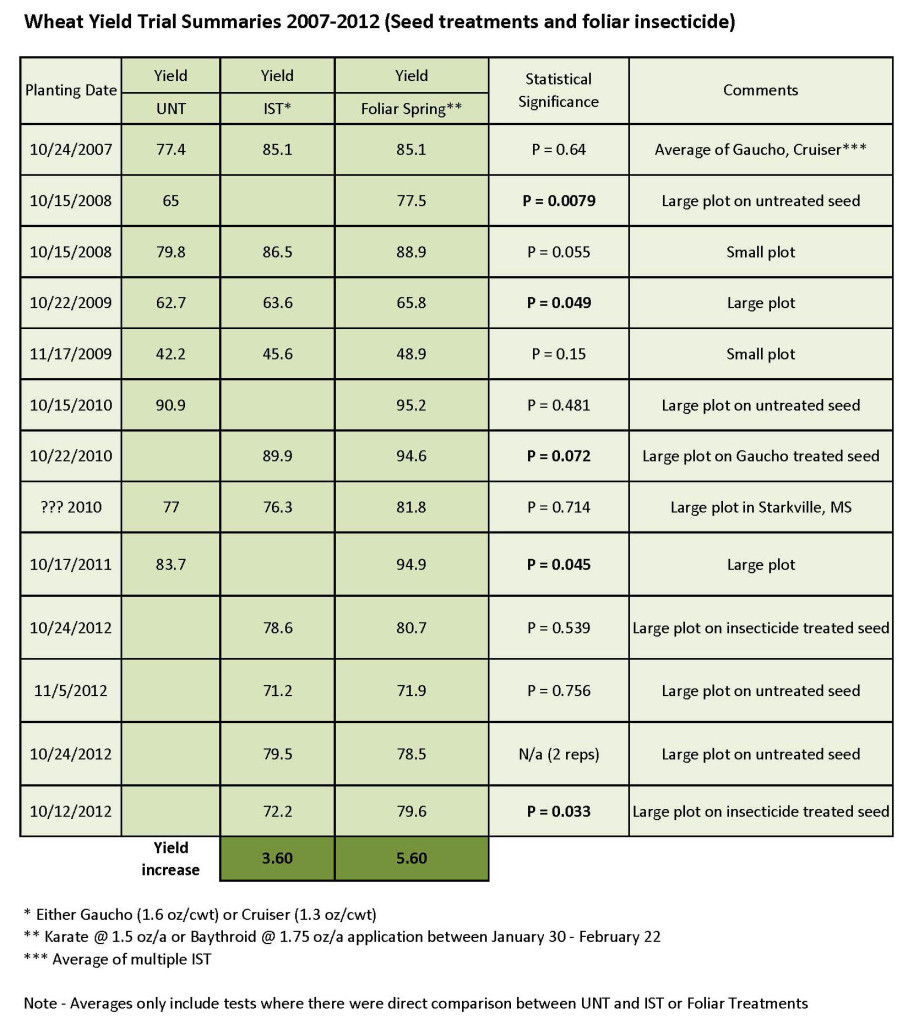General Comments: Much of this article is a blend and update of two articles written last year. Let me start by suggesting there are a lot of negatives and few positives of planting wheat prior to October in Tennessee.
- Wheat planted before the fly-free date, approximately October 15th for Tennessee, will be at greater risk to Hessian flies. Wheat planted too early can also serve as a nursery for the fall generation. The subsequent spring generation can seriously damage any nearby late-planted fields.
- Fall armyworms can do a number on September planted wheat. Fall armyworms populations have been conspicuously light this year, but there is no sense tempting fate.
- Aphid populations during the fall are typically higher in early planted wheat. Barley yellow dwarf virus (BYDV), which is transmitted by aphids, can reduce yields (see below). You may be able to use insecticide seed treatment or foliar insecticides to reduce fall transmission of the virus. But I see mostly risk without reward by planting too early.
Insecticide Seed Treatment Options for Wheat: In a nutshell, seed treatments offer the greatest value for wheat planted before the recommended fly-free date (approximately October 15th in Tennessee). A post-emergence foliar approach is a viable option if seed treatments are not used (see remarks below). If you plan on using a seed treatment, I’ve included a list of recommended products and use rates for the control of aphids (below). All should help reduce fall transmission of barley yellow dwarf virus by aphids.
Gaucho 600
Active ingredient – Imidacloprid
0.8 – 2.4 fluid ounces per 100 lbs. seed
Cruiser 5 FS
Active ingredient – Thiamethoxam
0.75 – 1.33 fluid ounces per 100 lbs. seed
NipsIt Inside (5F)
Active ingredient – Clothianidin
0.75 – 1.79 fluid ounces per 100 lbs. seed
All three of these products contain 5 lbs. of active ingredient per gallon and have a similar mode of action. The typical use rates applied by distributors is in the range of 0.8 – 1.0 oz of product per 100 pounds of seed. However, the highest labeled rates are recommended for control of Hessian flies. You should consider using these higher rates if you intend to plant before the recommended planting date, particularly if planting in September. Be advised that seed treatments should not be expected to control fall armyworms that sometimes infest early planted wheat.
Buyer Beware: Insecticide seed treatments are sometimes packaged with fungicides. But you will not get the recommended insecticide rate if applying some of these pre-packaged seed treatments at the labeled rate. For example, “CruiserMaxx for Cereals” and “NipsIt Suite for Cereals” contain insecticide in a much more dilute form than found in Cruiser 5F or NipsIt Inside. These products are typically marketed further north where aphids and BYDV is not a big issue. It would be necessary to add additional insecticide to achieve the recommended rates listed above.
Seed Treatments vs. Foliar Insecticides for Aphid Control: Over the last 6-7 years, we’ve studied how seed treatments or foliar insecticides impact wheat yields. Presumably, most of the effects we have seen are the result of aphid control and a reduction in BYDV as we routinely see both in our tests. The table below summarizes the results of multiple tests done since 2007. Here are some of my observations. Keep in mind that positive yield response to an insecticide seed treatment or foliar insecticide application are fairly consistent but do not always occur.
- It is uncommon to find many aphids during the fall and winter in wheat planted in mid-October or later. This observation typically holds true holds until late February or March when the wheat and aphid populations begin to grow.
- Insecticide seed treatments increased yield on average about 3-4 bushels per acre. This is consistent with previous data generated in Tennessee.
- A winter (late January-February) foliar application of insecticide, before aphid populations have begun to grow, has increased yields in my tests by an average of 5.6 bushels and as much as 12 bushels per acre. Most of these tests are on wheat not having an insecticide seed treatment, but we have observed some increases on wheat that did have and insecticide seed treatment.
My experience, based on less data, is that using both an insecticide seed treatment and a late winter foliar insecticide application is not necessary IF you plant in mid-October or later. In other words, the benefits of the seed treatment and the foliar application are probably not additive.
A seed treatment or foliar application of insecticide in the fall and spring may be necessary for wheat that is planted too early … or if aphid populations get an unusually early start. Scouting can help determine if a fall application of insecticide is needed for the prevention of BYDV.



One thought on “Wheat Insect Control Begins with Planting”
Comments are closed.